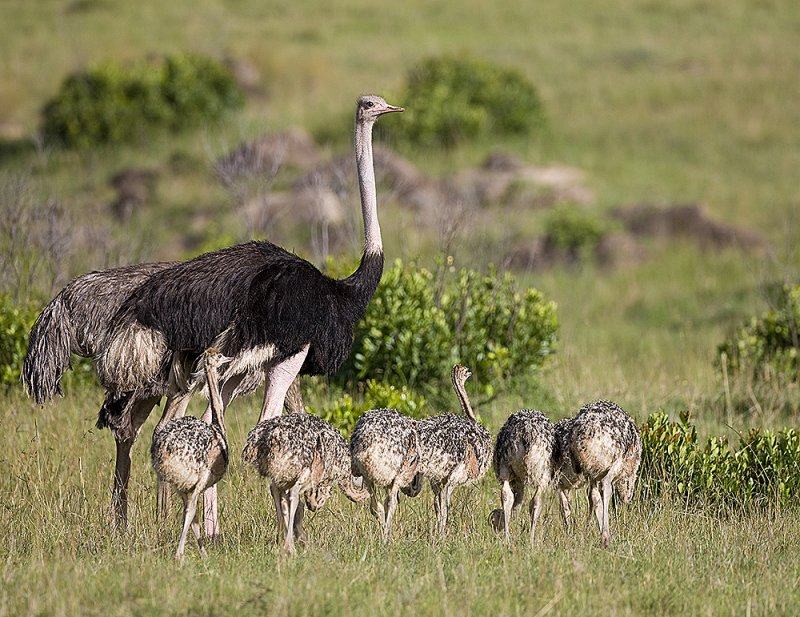Breeding ostrich

A few facts about ostriches are in order before discussing breeding ostriches. Cocks can be extremely defensive and hostile during reproduction. Vigilance should therefore be observed when entering their breeding areas. Keep in mind that ostriches, classified as ratites (flightless birds), are the largest living birds in the world. Adults can weigh between 70 to 150 Kg. A male ostrich stands between 6 and 9 feet and females range between 5.5 and 6.5 feet tall at maturity. They are fast runners and can maintain speeds between 50 and 80 Km per hour for 30 minutes with strides of 16 to 23 feet in length. Courtship of ostriches involves elaborate displays by both sexes.
Breeding in the temperate regions is seasonal often beginning in March and April and can go up to September. In the tropics like Kenya, the season is somewhat continuous and the length largely depends on food availability, bird condition and weather.
Grouping ostriches for breeding
Birds should be separated into breeding pairs around two months to the beginning of the breeding season. Groups of one male and two female birds can also be penned together. Bird condition is important because unhealthy and improperly conditioned birds will often be less productive egg layers.
Diet of a breeding ostrich
A poor diet may result in less egg production therefore breeding birds on pasture should receive daily supplements of a good quality, high protein poultry ration like layers mash to ensure optimum egg production, fertility, and hatchability. Breeders in confinement should be fed with layers mash ration with continuous supplemental feeding of good quality Lucerne hay. Access to oyster shell, grit, or other sources of calcium during the breeding period is paramount. Addition of poultry vitamins and electrolytes to the feed or water may improve fertility and hatchability.
Paddocking
Large paddocks are preferred although when oversized birds can become wild, playful and hard to control and eggs also will be more difficult to find and collect. One to three acres on a well drained area is a good paddock size for a breeding pair. Leguminous pasture should be planted to that ensures the birds have quality forage for grazing. Incorporate a few trees or shrubs in the pens to provide shade and privacy and help induce mating.
The paddock should be enclosed with 5-foot-high wire fence. To prevent fighting and injuries between cocks, construct a double fence between two paddocks with at least 6 feet between fences. Four to five strands of eight-gauge smooth wire is sufficient with posts spaced 10 feet apart. Never use barbed wire as birds will inevitably do serious harm to themselves. A hedge or windbreak is also good between pens to provide more privacy during courtship displays. The pen should have an area about 25 square feet by 6 inches deep of clean sand for the birds to roll in.
Egg production
Ostrich eggs are the largest of all eggs and weigh about 1¼ Kg. The content of one ostrich egg is equivalent to two dozen chicken eggs. Soon after mating, the female will lay between 12 and 15 eggs. A female usually lays an egg every other day. Eggs are normally laid in a shallow scrape. Collecting the eggs from the nest daily has the potential of increasing production up to 80 eggs, although 40 to 50 is more common. Egg production is variable but can exceed 70 eggs per year. Healthy hens may lay throughout most of the year--particularly if they are placed on an appropriate lighting program. Aggressive cocks can be fed and penned in a catch or holding pen while eggs are collected.
Well-nourished ostrich hens begin laying at approximately 2 years of age and are reported to have a productive life of more than 30 years. The reproductive performance of birds is regulated by the length of daylight per day. Lighting programs generally use a combination of natural daylight and artificial light to stimulate and maintain egg production and fertility in breeder birds. Time clocks should be used with artificial light sources in order to control daylength in a consistent manner.
Chicks
Ostrich chicks weigh about 45 Kg at 12 months of age. Domesticated ostriches reach maturity at 2 to 3 years of age. Females mature about 6 months earlier than males. Juvenile hens and cocks should be reared separately from 1 year of age to sexual maturity. Mature hens and cocks should be separated after the breeding season. This will allow the birds to be more rested and they will begin egg production more readily when placed together for the breeding season.
Cocks and hens
Eggs are usually infertile during the early part of the breeding season. This is usually caused by infertility in the cock. Breeding cocks should receive 16 hours of light per day beginning 3 to 4 weeks before being penned with their hens. After being placed together, hens and cocks should receive 16 hours of light per day during the entire breeding season. If the ostrich farm is located in an area of the country which has a natural daylength longer than 16 hours, et the time clock to match the longest natural daylength. After natural sunset, 2-5 foot-candles of artificial light intensity at head height should be adequate to stimulate and maintain egg production. Daylength must never be shortened and light intensity must never be decreased during the laying cycle. Three or four days of diminished light or shortened daylengths may cause the entire flock to almost completely stop egg production.



